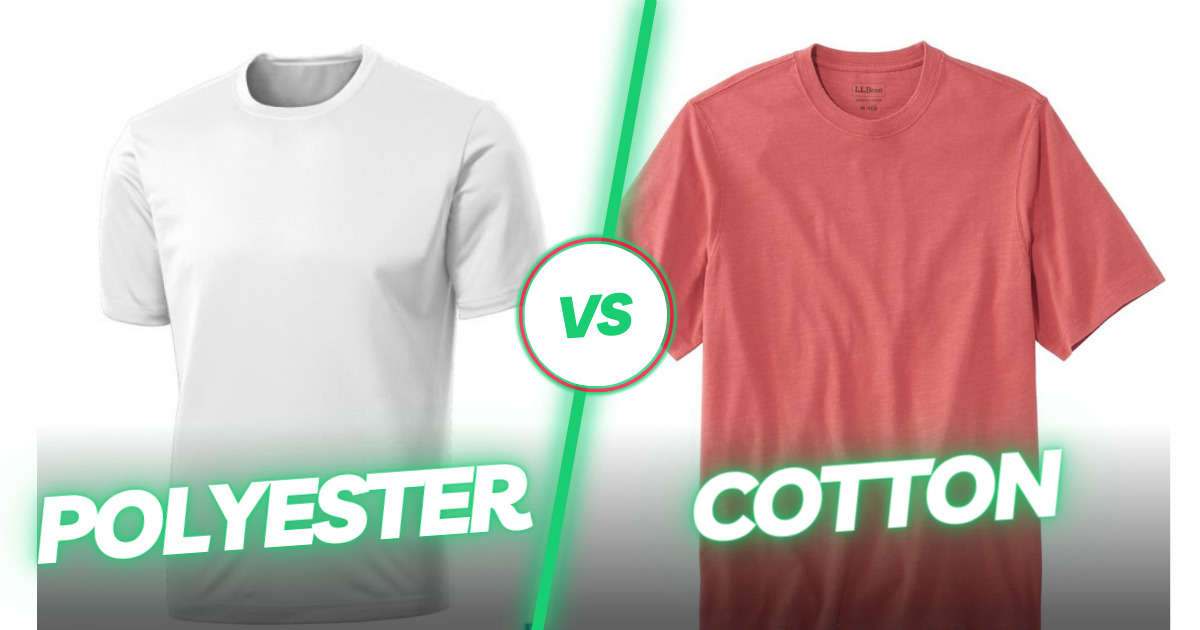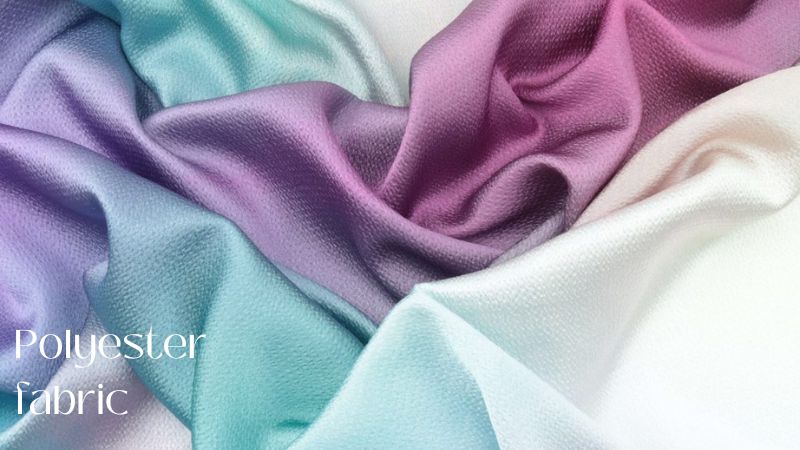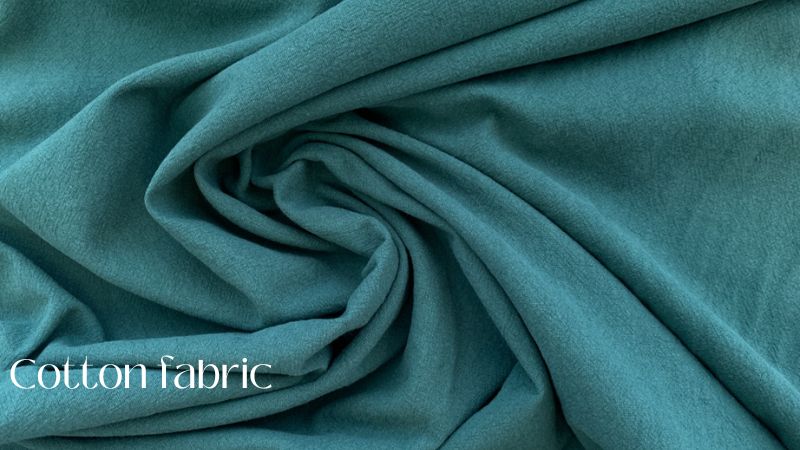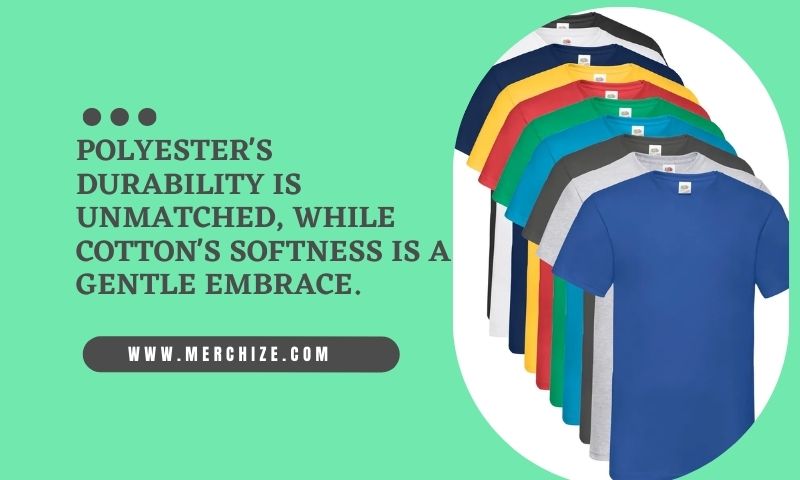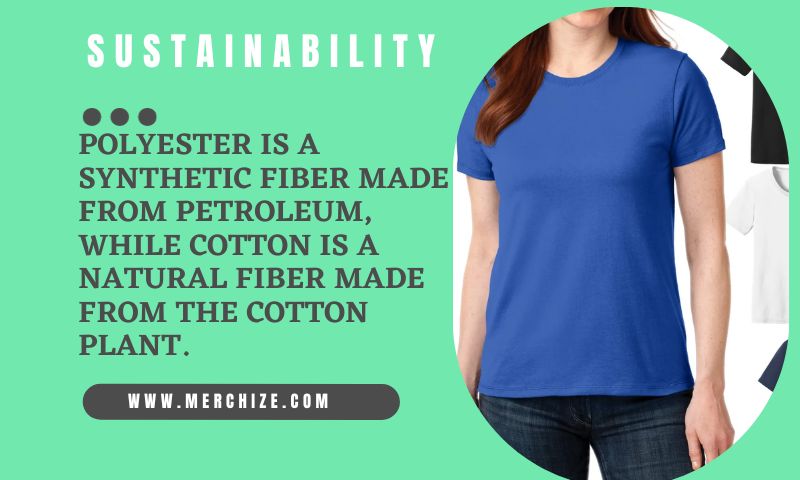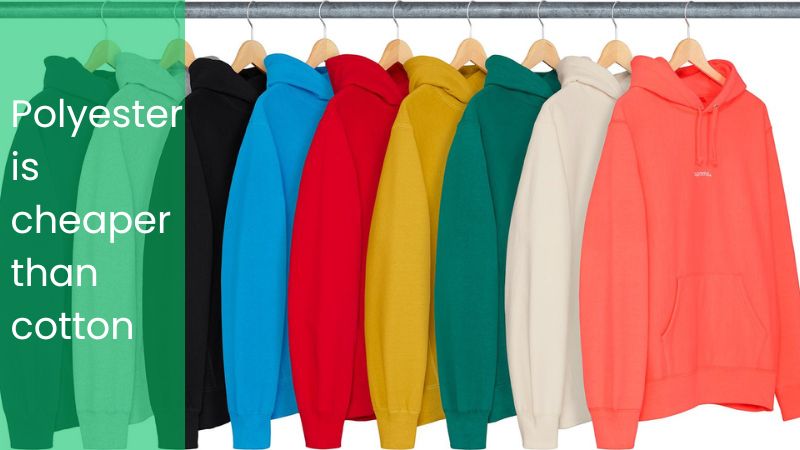Contents
Deciding between polyester vs cotton clothing can feel like an impossible choice – both fabrics have hardcore fans and detractors. Cotton touts its natural softness and breathability. Polyester flaunts its color vibrancy, wrinkle resistance and athletic-wear performance. How do you pick the right side for your apparel business?
As overwhelming as it seems, we’ll walk you through everything you need to confidently decide. We’ll examine how cotton and polyester compare point-by-point across factors like comfort, printability, environmental impact and cost. You’ll get the real truth behind common fabric misconceptions.
This won’t be your average unbiased debate – we aim to settle the cotton vs polyester score and declare a fabric winner based on print on demand priorities. But don’t worry, we have pro tips if you discover one fabric alone won’t cut it for your creations. By article’s end, you’ll have in-depth knowledge to pick your base apparel material and maybe even stop some laundry room disputes!
Polyester vs Cotton: Introduction
Cotton and polyester, often seen as the main players of the clothing scene, have been used in wardrobes, homes, and other places for decades. Their worldwide popularity isn’t just by luck, but because of the special features each one has. However, understanding the ins and outs of these fabrics is key if you want to make smart choices for different uses.
Polyester: The Synthetic Textile Star
Polyester struts onto the fabric scene as the celebrity of synthetics. But what exactly is this spotlight-stealing material? In short, polyester is a polymer-based fabric forged by chemists. Unlike natural textile superstars like cotton, polyester origins trace back to petroleum, not plants.
The polyester manufacturing saga starts with two petroleum-derived compounds – ethylene glycol and terephthalic acid. Fabric scientists combine these ingredients to form a polymer resin. This resin gets melted and squeezed through tiny holes to create long polymer strands called fibers. Weaving or knitting these synthetic fibers results in the fabric we call polyester.
Polyester fabrics like this cactus-patterned shower curtain flaunt unique performance perks. As a hydrophobic polymer, polyester repels water and dries swiftly. Its strong and smooth-surfaced fibers resist wrinkles as well as wear-and-tear. And manufacturers can dye polyester vibrant colors that won’t dare to fade. Thanks to its mechanical advantages, polyester replaced natural fabrics in multiple military applications during World War II.
In recent decades, heightened awareness around microplastics and textile waste has muddied polyester’s shine. Production and shedding polyester microfibers contribute to environmental pollution. Still, the unparalleled functionality and affordability of polyester fabric ensures its place under the textile spotlight. When combined with natural fabrics like cotton, polyester can balance sustainability and performance.
Cotton – The Textile Time-Tested by Civilizations
While polyester has roots in textile science labs, cotton traces back over 7,000 years as a fabric birthed by nature itself. The story starts inside protective seed pods grown by cotton plants. As pods ripen and crack open, fluffy cotton fibers emerge, ready to be transformed into threads.
Ancient civilizations cottoned on to the potential of these fibers. Evidence shows societies in India, China, South America and beyond cultivated cotton for early textile production. Cotton offered notable advantages over fabrics common at the time like wool. Lightweight cotton moved with bodies to beat the heat and wicked away moisture with ease. Societies could also dye cotton vibrant colors with relative simplicity.
Cotton successfully stood the test of time thanks to such desirable properties paired with renewability. As cotton fibers come from plants annually harvested, cotton supplies could support booming empires. Trade spread cotton and artistry like embroidery to regions slow to adopt it, including medieval Europe. Cotton gradually replaced scratchier fabrics for its praised softness and comfort.
Today, cotton stays in the limelight as the darling of natural textiles and makes up close to half the global textile output. Clothing brands bank on cotton’s breathability and beloved feel to move stock. Home goods tout cotton origins for credibility. And sustainability proponents promote cotton’s biodegradable nature as eco-friendly. However, all-cotton products wrinkle easily and may shrink without care – small prices to pay for fabrics with millennia-long testimonials.
Pros and Cons of Polyester and Cotton
| Polyester | Cotton | |
| Pros |
|
|
| Cons |
|
|
The difference between cotton and polyester overview
Here is a table that summarizes the key differences between cotton and polyester:
| Property | Polyester | Cotton |
| Fiber type | Synthetic | Natural |
| Absorbency | Low | High |
| Breathability | Good | Excellent |
| Wrinkle resistance | Excellent | Poor |
| Durability | Very good | Good |
| Sustainability | Low | High |
| Cost | Relatively low | Relatively high |
Printability of Polyester and Cotton
Both polyester and cotton can be printed on with high-quality results. However, there are some key differences between the two fabrics in terms of printability.
Polyester: The Printing Challenge
Polyester, with its synthetic origins, is inherently hydrophobic—meaning it repels water. This very characteristic can make printing a tad challenging. As fabric experts often say, poly’s build can create fiber balls and, sometimes, loose threads. This, combined with its water-repelling side, means that traditional inks might not stick smoothly to its surface. However, today’s tech stepped up! Cool inks and new ways have come up, making sure that poly gets decorated with bright, awesome prints even with those first hurdles.
Cotton: The Printer’s Friend
In stark contrast, cotton welcomes prints with open arms. Its hydrophilic nature, which translates to water-absorbing, ensures that inks find a conducive environment to latch on. This makes the printing process relatively straightforward. But, there’s a catch. Cotton’s natural propensity means that post-print, it’s susceptible to shrinkage and wrinkle formation. So, while the first printing might be a breeze, you have got to be careful after to keep the design’s quality and make it last.
Durability of Polyester and Cotton
Durability matters when you’re picking a fabric, especially for items that’ll be used a lot or in tough spots. Both polyester and cotton can last, but they have their good and bad.
Polyester: The Epitome of Endurance
Polyester earns accolades for its sheer resilience. Its synthetic origins imbue it with qualities that make it stand the test of time. More resistant to wear and tear, polyester doesn’t just promise longevity—it also offers an impressive defense against the everyday nuisances of stains and wrinkles. So, if you want fabric that’s low maintenance and can handle daily life, polyester’s a winner.
Cotton: Gentle and Graceful
Nature’s very own, cotton, is a testament to softness. Its fibers offer an unparalleled tactile experience, making it a favorite for those who prioritize comfort. However, every silver lining has its cloud. Cotton’s softness comes with a susceptibility to challenges. Cotton can get small with heat, and its colors might fade quicker than you’d like, especially if it gets too much sun or strong detergents. In essence, while it brings comfort to the table, it demands a tad more care in return.
A Comparative Glimpse
At a glance, while polyester boasts superior durability, cotton woos with its skin-friendly embrace. Both fabrics come with their set of pros and cons, and the choice between them often hinges on the specific needs of a project. Are you looking for something that stands up to rigorous use? Polyester might be your ally. If comfort and a gentle touch are the priority, cotton takes center stage.
Want to dive deeper into the world of fabrics? Explore our next article, “Best Shirt Material" to make an informed choice!
Sustainability of Polyester and Cotton
Sustainability is a growing concern for consumers, and many people are looking for ways to reduce their environmental impact. When picking out fabrics, it is important to consider the sustainability of both the fiber itself and how it’s made.
Polyester: Unraveling its Green Score
Pros:
- Durability Advantage: Its longer lifespan, compared to cotton, suggests less frequent replacements and theoretically less waste. However, the whole lasting thing depends on if the clothing is good quality, since a lot of cheap polyester material is just meant for a short time.
- Lower Land & Water Footprint: Unlike cotton, polyester doesn’t necessitate extensive land and water utilization.
Cons:
- Carbon Footprint: Originating from fossil fuels, so making polyester is responsible for a huge chunk (like 40%) of fashion’s carbon mess.
- Chemical Concerns: Making it has a mix of chemicals, and some are kind of nasty. This can mess up our water.
- Microplastic Menace: Washing polyester garments releases microplastics, which eventually find their way into aquatic ecosystems, affecting marine life and, indirectly, humans.
- Recycling Challenges: Though technological advancements have been made, turning polyester back into something useful is tricky.
- Decomposition Dilemma: This type of polyester won’t break down easily; think about waiting for 200 years!
Cotton: Nature’s Offering with Caveats
Pros:
- Natural and Renewable: Since it’s from a plant, cotton is renewable and doesn’t rely on fossil fuels.
- Recyclability: Cotton garments can be recycled with relative ease.
- Biodegradability: Unlike many synthetics, cotton naturally decomposes over time.
Cons:
- Pesticide Predicament: Cotton farming consumes 6% of global pesticides and 16% of insecticides, leading to significant water pollution.
- Water Guzzler: Cotton is notoriously water-intensive; a single t-shirt can demand up to 2,700 liters.
- Soil Degradation: Intensive cotton farming can degrade the soil, making it unsuitable for other crops.
- Potential Non-biodegradability: If cotton is chemically treated or mixed with synthetics, its biodegradability can be compromised.
Polyester vs. Cotton: Navigating the Sustainability Labyrinth
The sustainability debate between polyester and cotton is far from black and white. Both have their merits and pitfalls. Even though cotton, being all natural, seems like the go-to green choice, we can’t forget its farming issues. And yeah, polyester’s planet problems are big, but there are new ideas like reused polyester, made from old plastic bottles, giving better green options.
Cost of Polyester and Cotton
Is polyester cheaper than cotton? In most cases, yes. Polyester is generally less expensive to produce than cotton, making it a more affordable choice for clothing manufacturers. However, the price of both fabrics can vary based on factors like quality, garment type, and brand.
Polyester: The Economical Marvel
Factors Contributing to Polyester’s Cost-Efficiency:
- Nature of Origin: Being a synthetic fiber, polyester’s starting materials—mostly petroleum—are abundant and, in many contexts, cheaper to source compared to natural fibers.
- Ease of Production: Polyester’s manufacturing process, though chemical-intensive, is streamlined, making it relatively cost-effective. In contrast, cotton’s cultivation demands extensive land, water, and labor resources.
- Durability Dividends: Clothes made from polyester usually last longer than cotton ones. Over time, this means you spend less since you don’t have to buy new stuff as often.
Cotton: Quality with a Price
Factors That Can Elevate Cotton’s Cost:
- Quality Gradient: High-quality cotton, especially kind called organic cotton (grown without fake bug-killers or plant-killers), can be pricier. The added cost is a reflection of sustainable agricultural practices and the resultant product quality.
- Design Complexity: Cotton’s cool because you can do a lot with it, like super detailed designs or new fabric tricks. Of course, that means you gotta pay more for it.
- Branding Influence: Established brands, recognized for their quality and trustworthiness, can price their cotton garments at a premium, given the brand equity they’ve built over time.
Market Dynamics: A Brief Insight
The financial nuances of polyester and cotton aren’t solely dictated by their inherent attributes. External market forces play a role too. Cotton, being a globally traded commodity, sees its prices swayed by futures trading. Meanwhile, polyester’s price structure is often influenced by trade policies and relations, particularly in countries like the U.S.
Choosing the Right Fabric for Your Print on Demand Business
The cost of polyester and cotton can change based on a bunch of reasons, including the quality of the fabric, the type of garment being made, and the brand of the clothing. However, usually, polyester is usually less expensive than cotton.
Product Type and What You’re Going For
- Sportswear & Activewear: If your business leans towards crafting activewear or sportswear, polyester is the best pick. With its ability to pull sweat away, how long it lasts, and its stretchiness, it provides the use that active folks are looking for.
- Everyday and Chill Clothes: On the other hand, if you’re thinking of a line that feels comfy, soft, and has a chill vibe, cotton is your best bet. Its natural breeziness and soft feel make it a top choice for everyday clothes.
Figuring Out Your Ideal Customer
- Eco-Conscious Consumers: As environmental concerns gain momentum, a segment of consumers actively seeks sustainable options. If you want to attract these earth-loving folks, cotton, especially the organic kind, is what you need. Its natural roots and the fact that it breaks down easily align with eco-friendly picks.
- Bargain Hunters: For consumers who prioritize durability, ease of maintenance, and saving a buck, polyester is where it’s at. It’s tough nature combined with its usually lower price makes it a great deal.
Budget Considerations
- Starting Cost: When it comes to price tags, polyester usually is easier on the wallet, mostly ’cause it’s man-made and they make it super efficiently. This is super handy for businesses that are just kicking off or are on a shoestring budget.
- Future Gains: While the upfront cost matters, you also have got to think about the gains down the road. Splurging a bit on quality, be it polyester or cotton, can lead to happier customers, them coming back, and a cooler brand image.
In the complex world of fabrics, getting the differences between polyester and cotton is a must if you wanna rock in the print on demand business. From toughness and price to being eco-friendly and comfy, each material has its perks. Budding business folks should think about these things before deciding. Partnering with trusted platforms like Merchize, a leading Print On Demand and Fulfillment service, can further streamline the journey, ensuring a seamless store launch and operation.
FAQs
1. Should you choose jackets made from synthetic materials or natural cotton?
Natural fabrics like cotton, wool, or leather are generally better for both your health and the environment. Unlike synthetics, they don’t shed microplastics – tiny fibers that now pollute every corner of the planet and have even been found in human bloodstreams and newborns. While synthetic jackets may seem convenient, natural materials can last for decades if cared for properly. If sustainability and long-term value matter to you, natural fabrics are the smarter choice.
2. Is polyester bad?
Polyester isn’t inherently bad, but it comes with trade-offs. While it’s durable and low-maintenance, it’s made from petrochemicals, doesn’t breathe well, and tends to trap sweat and odors. For many, these downsides outweigh the convenience. One Reddit user shared they removed all polyester from their wardrobe, choosing only natural fibers like cotton, linen, wool, silk, or bamboo-based fabrics (e.g., viscose, lyocell, modal). These materials not only feel better on the skin but also age more gracefully and align better with sustainable living. If comfort, breathability, and environmental impact matter to you, natural fabrics may be a better long-term choice.
3. What are some quality fibers for t-shirts?
High-quality t-shirts are typically made from cotton jersey knit fabric – a soft, breathable, and slightly stretchy material that offers comfort and good drape. Most t-shirts have some degree of stretch, even if it’s subtle, due to the knit construction. If you’re looking for non-stretch options, lightweight woven fabrics like cotton lawn or sateen may be alternatives, though they’re less common for t-shirts. Keep in mind that off-the-bolt fabrics often feel stiff due to temporary treatments, but a vinegar wash can help restore softness. For the best quality, it’s recommended to shop at specialty fabric stores rather than large craft chains, as fabric quality can vary significantly.
